From the iPad to Oculus, every major technological innovation over the past ten years has played out on Twitter, fueled by influential early adopters who use the platform for an ongoing dialogue about tech.
To better understand Twitter’s role as a hub for early adopters and tech influencers, as well as our place in the technology consumer decision journey, we partnered with Zeitgeist Research (an independent market research firm) to uncover what this audience is buying, how they make decisions, and how the platform influences their process.
We studied Twitter users and non-users across five consumer electronics categories, ranging from early to wide adoption¹ ², and discovered eight important insights into technology purchase behavior as it relates to category maturity on Twitter.

Insight #1: Twitter over-indexes on early adopters and influencers
Twitter users are thoughtful, influential early adopters of consumer technology who use the platform for an ongoing, active dialogue about tech. Twitter provides a platform for these early adopters to broadly and publicly share their opinions, giving them significant influence over a product’s popularity and potential adoption. This amplification contributes to a 59% greater likelihood of reaching those intending to make consumer technology purchases on Twitter.³

Insight #2: Twitter is the first and last place tech consumers land on their decision journey
Across all five categories we researched, Twitter was an integral part of a consumer’s path, particularly pre- and post-purchase. 42% of Twitter users say the platform has played a valuable role in a recent tech purchase.
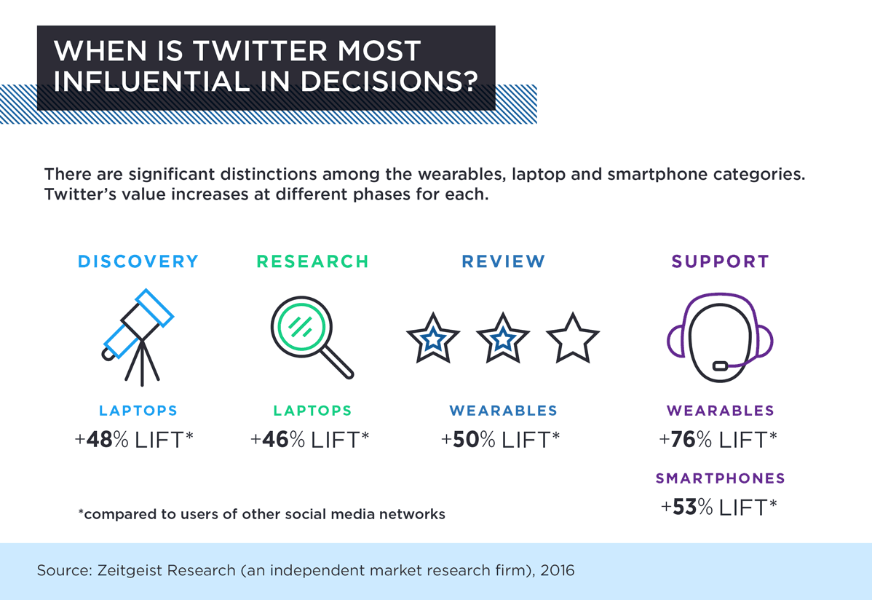

Insight #3: If it’s new or niche, they want it
Twitter users want what’s new and what’s now, and are more likely to buy products from an emerging or niche category than non-Twitter users.
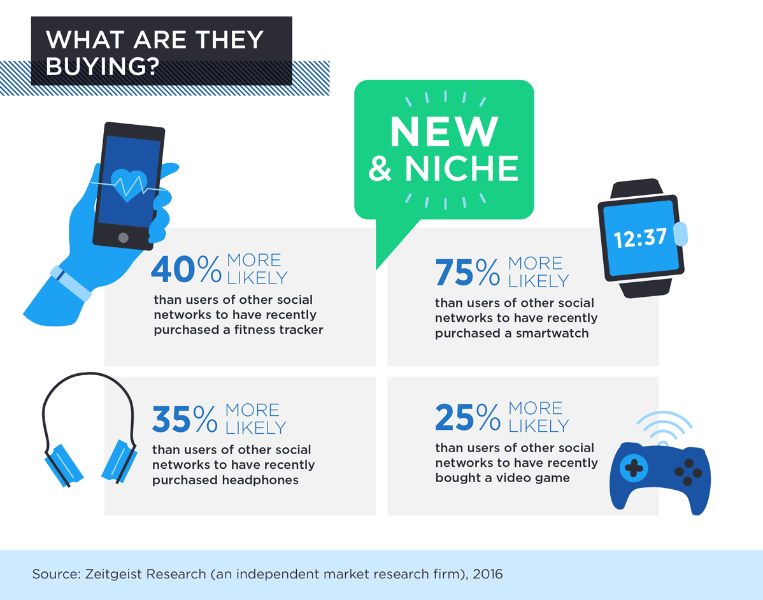
Insight #4: Wearables: Twitter > other social networks post-purchase
For the growing wearables category, Twitter users find the platform more valuable for review, discussion, and assistance with their purchase. As early adopters and influencers, they are looking to share their thoughts and experiences with an interested, engaged community.

Insight #5: Laptops: Twitter > other social networks pre-purchase
For big-ticket purchases in the well-established laptop category, Twitter users want to be sure of their decision and will do the work up front to make the best product choice.

Insight #6: Smartphones: Twitter > other social networks for support
In the ubiquitous smartphone category, Twitter allows technology consumers to connect one-on-one, in real time, with peers, brands, and experts. Twitter users find this personalized, immediate support particularly valuable.

Insight #7: Twitter users have high standards
Twitter users care about quality and brand reputation, and they do their research, no matter what the category. They rely on expert opinions and reviews from friends and colleagues.
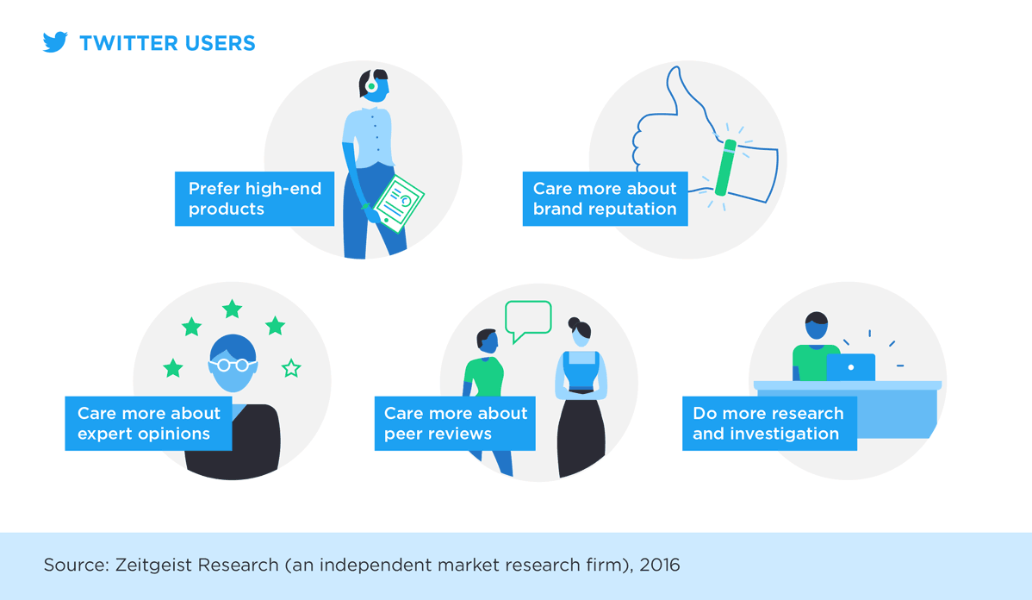
Insight #8: Twitter users take action
Twitter users put a lot of thought into their technology purchases, but they move quickly once they decide to buy. Across the categories we studied, two-thirds of Twitter users made their purchases within a week.
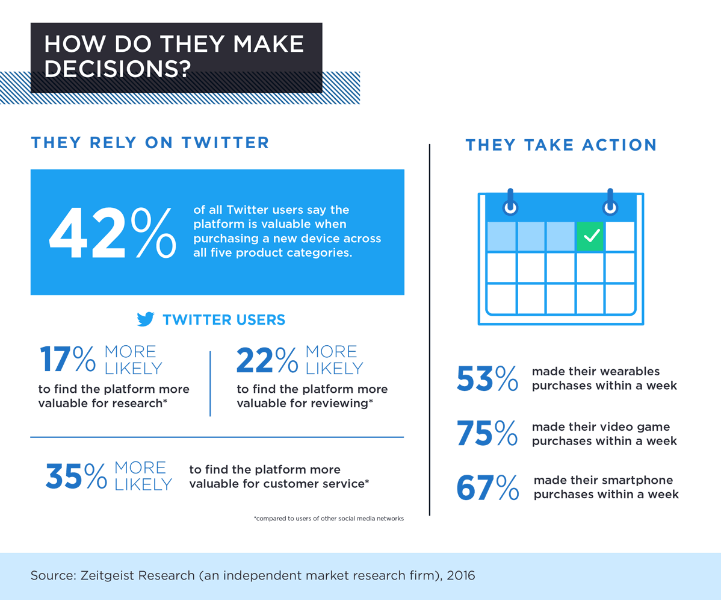
Our research into the technology consumer decision journey reveals key insights into how consumers use Twitter, and how their behavior changes based on category maturity and purchase process stage. Applying this knowledge can help brands reach tech enthusiasts at key points of impact along the customer journey.
Key takeaway #1
Twitter is a place for early adopters. They are the most likely to purchase emerging technologies like wearables, and they use the platform to share their experiences in real time. When launching products in new categories on Twitter, be ready to listen and engage with early adopters who are looking for news and content. Amplify positive reviews and respond when questions are asked and support is needed.
Key takeaway #2
Tech influencers’ conversation around emerging tech categories on Twitter can be an early indicator of broad category adoption.
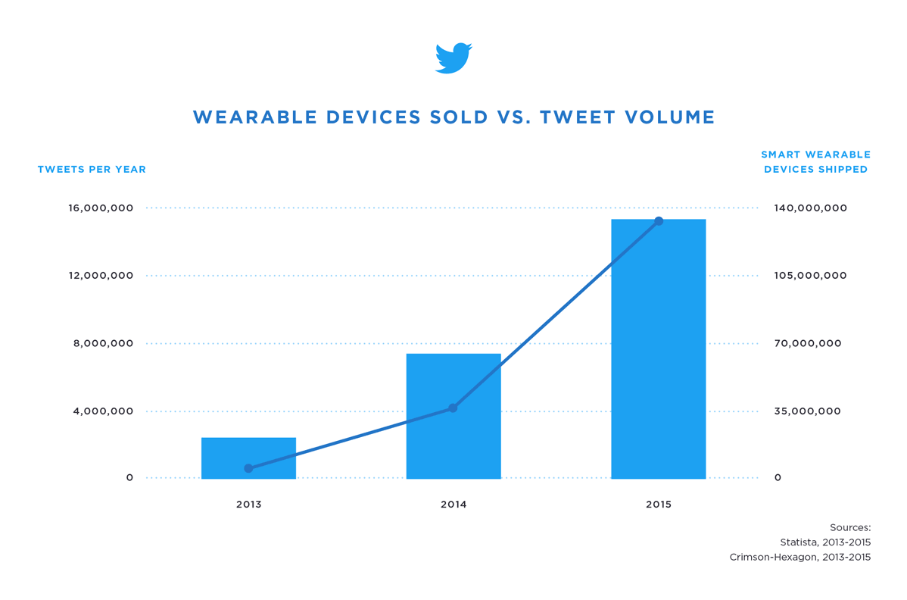
Get influencers invested in your product by granting them early and/or inside access. Help them understand key product benefits, encourage them to be your voice, and surprise those who share with exclusive experiences.
Key takeaway #3
Our research has revealed that Twitter is a live connection to technology consumers at nearly every point along their purchase decision journey. Make sure you reach them in their consideration window with competitive messaging and promoted Tweets and Trends. Continue to inspire and encourage conversation post-purchase by helping customers get more out of their devices and services, and by offering friendly, personalized service on Twitter.
Join us for #Twitter4Tech live on Periscope on Thursday, April 21 at 3pm PT. Follow @TwitterAds for more details and to tune in.
¹ Source: Consumer Electronics Association (2015) “17th Annual CE Ownership and Market Penetration Study
² Source: Electronic Software Association (2015) Essential Facts About the Computer and Video Game Industry
³ Source: comScore Custom Research, Multi-Platform, January, 2016, USA
Zeitgeist Research study commissioned by Twitter n=2,000 (n=1500 Twitter users, n=500 Social Media Network users). All differences statistically significant at the 95% confidence level.
Did someone say … cookies?
X and its partners use cookies to provide you with a better, safer and
faster service and to support our business. Some cookies are necessary to use
our services, improve our services, and make sure they work properly.
Show more about your choices.